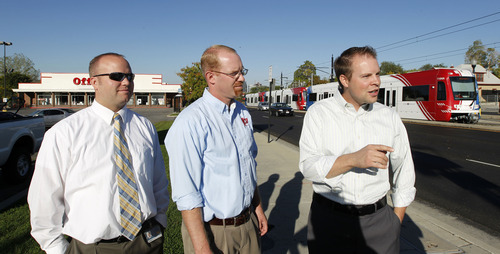This is an archived article that was published on sltrib.com in 2012, and information in the article may be outdated. It is provided only for personal research purposes and may not be reprinted.
Salt Lake City's 900 East TRAX station, which faces an often-vacant parking lot, could soon be serving a massive student-focused apartment complex, the first of its kind near the University of Utah, under a proposal crafted by a team of business students.
The group is seeking financing and approvals for its proposed five-floor University Station, housing up to 464 residents in 140 units on a 2.24-acre lot currently occupied by a sleepy Office Max store at the southwest corner of 900 East and 400 South.
"The reason [students] aren't moving close to campus is there's no product. They don't want a two-bedroom, one-bath apartment. Four-bedroom apartments don't exist," partner Justin Earl said. Housing is "catering to the general market, not students."
Crafted by Earl, Allen Argyle and Nathan Erickson, the proposal won this year's Utah Real Estate Challenge.
The $40 million proposal "has legs," said the property's owner, Rick Birdoff, who is helping pay for a market analysis. "We think there is some viability. It could be a higher and better use than currently exists," he said.
Birdoff's New York City holding company controls 20 million square feet in retail space, but he said the Salt Lake City property is very much on his radar. Some of his properties have been developed for student housing, such as a new complex serving University of Florida students in Gainesville.
Birdoff would like to see Office Max accommodated in ground-level retail space. "Office Max is a great tenant," Birdoff said. "It's important to have a mixed-use there."
City officials have yet to see the plan, but they say its concept fits squarely within they city's vision for that intersection.
"It has been a city policy to see the university better utilize off-campus amenities particularly in connection with downtown. That's one of the reasons 400 South has been renamed University Boulevard," said Nick Norris, the city's planning manager. "We want to increase housing near our TRAX stations. Those are the right places to accommodate growth."
The property to the south, featuring a shuttered rec center, is slated for redevelopment for high-density housing, Norris noted. Running diagonally under the Office Max property is storm-water canal that would likely have to be moved.
University Station calls for a U-shaped building fronting 400 South. Parking would be provided one level below grade and at grade level. A landscaped patio with a barbecue pit, pavilion and hot tub would cover the grade level parking.
In Provo, dozens of apartment buildings provide off-campus housing with a student focus near Brigham Young University, which Argyle and Earl attended as undergraduates.
"Here there is zero. It's mind-boggling," said Earl, who lived in such an apartment near BYU and loved its vibe, with gatherings almost every evening.
Student-focused apartments are vastly different than typical apartment complex. Units have four to eight bedrooms, as opposed to two, and occupants are liable for just their share of the rent, not the entire bill. Leases cover the nine months of the academic year, and apartments come furnished.
"Community gathering areas are more important in student housing where residents want to be social, whereas typical apartment complexes don't need to have as much community gathering space," the team wrote.
The U. has 2,800 beds available for single undergraduates. Last year the beds were 98.2 percent full and 587 students were on a waiting list, according to U. housing officials.
"There's not enough housing on campus to serve incoming freshman, let alone sophomores, juniors and seniors looking for a social environment," said Earl, who completed a master's degree in real estate development at the U. along with both his partners.
Lots of undergraduates, as many as 10,000, are hunting for rooms near campus, but what they find are mostly old homes chopped into units and apartments that are geared toward non-students.
"Students are being forced to settle for inferior housing options, or have larger commutes for better housing options, perpetuating the perception that the U. is a commuter campus," the team wrote in the proposal.
In its market study, the team examined 22 off-campus apartments where U. students reside. Just two were built in the past decade; five are within three miles of campus; all but one was more than 90 percent full last year; five offered school-year leases; one is furnished; and none offer four-bedroom units.
University Station would offer mostly 1,100-square-foot four-bedroom furnished units with free Internet and cable and ample common space, both inside and outside the apartments. It would be located one train stop away from the U. stadium to the east and one stop from the city library to the west. It's almost as close to the heart of campus as U. residence halls at Fort Douglas, but without the no-alcohol policies of campus and easier access to downtown and Trolley Square.
It could also serve students at Westminster and LDS Business colleges.
If it opens in three years, University Station rents would be $595 a month, about $70 less than the U.'s most expensive on-campus option, the new 309-bed Marriott Honors apartments.
University Station
Student apartment complex proposed for the southwest corner of 900 East and 400 South, next to the TRAX station. The 177,000-square-foot, five-story building would have rooms for up to 464 students in 140 units. The backers are three recent University of Utah business school graduates whose proposal, which addresses the dearth of student-focused housing near campus, won the Utah Real Estate Challenge.



